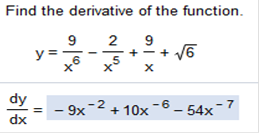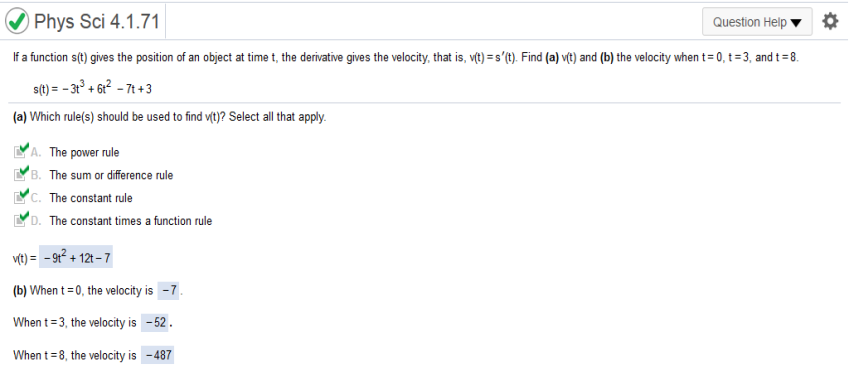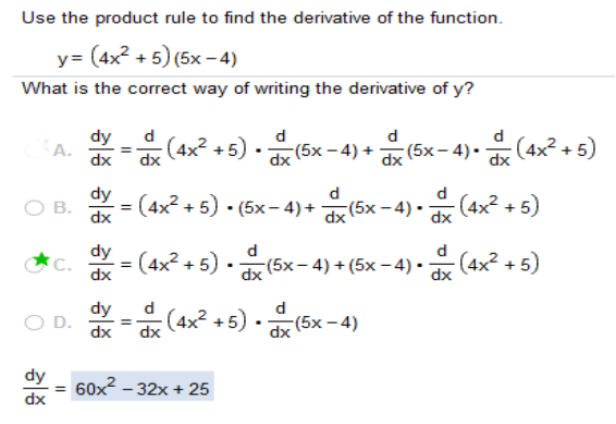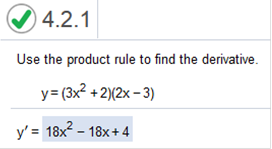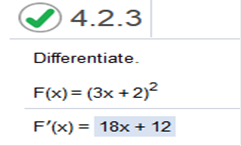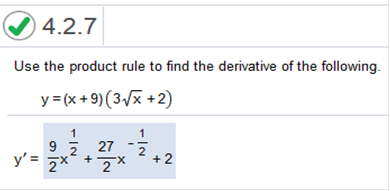|
Accounting | Business | Computer Science | General Studies | Math | Sciences | Civics Exam | Help/Support | Join/Cancel | Contact Us | Login/Log Out Homework Chapter
1A 1B 2A 2B 3A 3B 4A 4B 5A 6A Chapter Tests 1 2 3 4 5 6 7 FINAL EXAM Need A Tutor? Need Homework Help?
Calculus For Business Homework Chapter 3 Part A 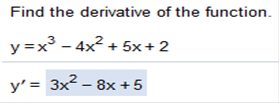
x3 · n-1 = 3 · x3 – 1 = 3x2 4x2 · n-1 = 2 · 4x2 – 1 = 8x 5x · n-1 = 1 · x1 - 1 = 5 2 · 0 = 0 y = x3 – 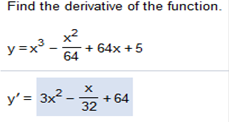
Find the derivative. This is the same as above. x3 – x3 – Now we simplify 3x2 - 
dy/dx = 10x + 4x-3 – 2 y = 5x2- 2x - 2x-2 Find derivative of 5x2 - 2x - 2x-2 We can break this down. The derivative of 5x2 = 10x -2x = -1 -2x-2 = 4x-3 Now we put the equation back together in proper order. 5x2 + 4x-3 – 2 Please note: sometimes a term with a negative exponent will appear in fraction form. In this case, 4x-3 could appear as 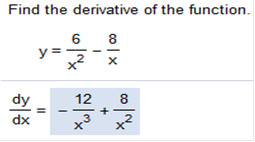
We need to find the derivative of the equation. The easiest way for me is to move the exponents up to the numerator and find the derivative. Then we would need to put the equation back into fraction form. *2 Notes: When we move an exponent up to the top, the exponent is then negative. The derivative of a negative exponent would mean to multiply a negative number add -1 to the negative exponent. For example, if we have 2x-2, the derivative would be -4x-3 (fraction form Here are a few more examples, so you can get an idea of what is going on. The derivative of 2x-2 = -4x-3 fraction form = The derivative of 3x-3 = -9x-4 fraction form = The derivative of 4x-4 = -16x-5 fraction form = I like to move exponents on the bottom to the top, Because it can become very confusing otherwise. The choice is up to you! Here we go The derivative of 6x-2 = -2(6x)-2 – 1 = -12x-3 = fraction form - 8x-1 = -1(-8x)-1 -1 = 8x-2 = fraction form Find the derivative of the function
The square root is eliminated anyway because there is no variable. The derivative of √6 = 0. No worries! This is a little confusing as well because we will need to rearrange the order. Just so you know, -1 is greater than -2, -3, and so because negative values closest to 0 come first, from left to right. The greatest value comes first. The problem is not in order from the get-go. I am going to do this the way I want again. Move exponents up to the top. I can actually do these in my head And jot the number down as I go along, but it is a good idea to practice these on your own. AND this answer will not be in fraction form, so we would need to convert the expressions anyway! Now all we need to do is break the equation down, find the derivative and rearrange. Derivatives 9x-6 = -54x- -2x-5= 10x-6 9x-1 = -9x-2 The answer in proper order -9x-2 + 10x-6 - 54x-7 y = 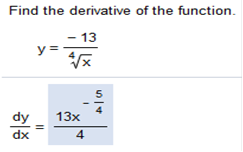
First, we can rewrite the equation and eliminate the radical (square root) There are a few ways to do this, however we will stick to the way I showed you above. Next, we can move the exponent to the top like we have been doing. Now we can find the derivative. Watch closely at how I find the derivatives for each expression. We would multiply -13 by Next we must add -1 to which is the same as Now we can put the equation back together 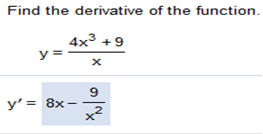
This one is a little tricky, however, this is how I would solve it and find the derivative. Please note we need to divide both expressions by x (or x1) and x1 will be negative as well. Now we will move x to the top and remember anytime we move an exponent up We must subtract it from a like term. So, we have Now we find the derivatives and put the equation back together. the derivative of the derivative of 9x-1 Since we can see the answer is in fraction form, we can move the variable and exponent down (it becomes positive again). 8x – 9x-2 = Which of the following describes the derivative function f’(x) of a quadratic function f (x)? Answer: Linear 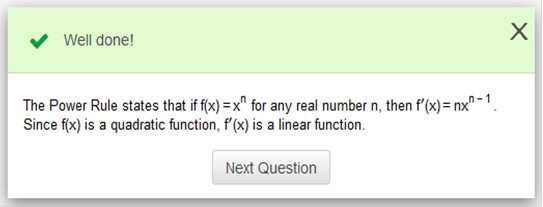
Explain the relationship between the slope and the derivative of f(x) at x = a Answer: The derivative of f(x) at x = a equals the slope of the function at x = a. Find the equation of the tangent line. y = x4 – 2x3 + 9; x = 1 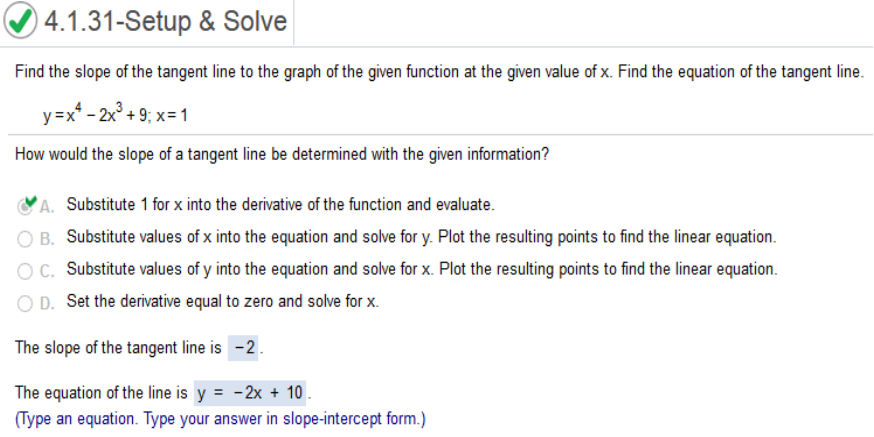
y = x4 – 2x3 + 9, x = 1 First, we need to find the derivative of y = x4 – 2x3 + 9 = 4x3 = 4x3 – 6x2 plug in the value of x = 1 4(1)3 – 6(1)2 = -2 Slope = -2 y = mx + b -2(1) y = (1)4 -2(1)3 + 9 = 8 8 = -2(1) + b 8 = -2(1) + b = add 2 to both sides b = 8 + 2 = b = 10 y = -2x – 10 https://www.mathepower.com/en/tangent.php f(x) = x4 − 25x2 + 144; x = 2 The Slope tangent line is -68 (Simplify your answer) The Equation of the tangent line y = -68x + 196 
Find the derivative of f(x) = x4 −25x2 + 144 = 4x3 – 50x Plug in x = 2 4(2)2 – 50(2) = The slope of the tangent line is -68 y = (2)4 – 25(2)2 + 144 = 60 the tangent line passes through the point (2,60) and has slope -68 y – y1 = m(x – x1) y – (60) = -68(x – (2)) y = -68x + 136 + 60 The equation of the tangent line is y = -68x +196 Cool calculator enter equation https://www.mathepower.com/en/tangent.php 
Find the derivative of 6x2 – 27x + 27 f(x) = 6x2 – 27x + 27 = 12x – 27 set to equal 0 12x – 27 = 0 = 9/4 Plug in x to find the y slope f(9/4) = 6(9/4)2 – 27(9/4) + 27 = -27/8 x = 9/4, y = -27/8 points on the graph = (9/4, -27/8) https://www.emathhelp.net/calculators/calculus-1/function-calculator/ enter equation Critical Points (9/4, -27/8) How does the marginal cost relate to cost? A. Marginal cost refers to the rate of change of cost. B. Cost refers to the rate of change of marginal cost. C. Marginal cost is the same as cost. production levels (values of q). (Hint: Solve the demand equation for p and use R(q) = qp.) 
P = 7000 – q / 100 Rq = q (7000 – q / 100) Rq = 70q – q2 / 100 Find derivative of 70q – q2 / 100 = d/dq (70q – q2 / 100) = 70 – q/50 Plug in 1000 units 70 – (1000 / 50) = 50 The marginal revenue at 1000 units is 50 3500 units 70 – (3500 / 50) = 0 4000 units 70 – (4000 / 50) = -10 M(t) = 0.05026t3 - 1.125t2 + 37.81t + 247.3 where t represents the number of years since 1990 and M(t) is in billions of dollars. Find the derivative of M(t) and use it to find the rate of change of money in circulation in the following years. What do your answers in parts a-d tell you about the amount of money in circulation in those years? The amount of money in circulation in those years increases from 1990 to 2005.increases from 1990 to 2005 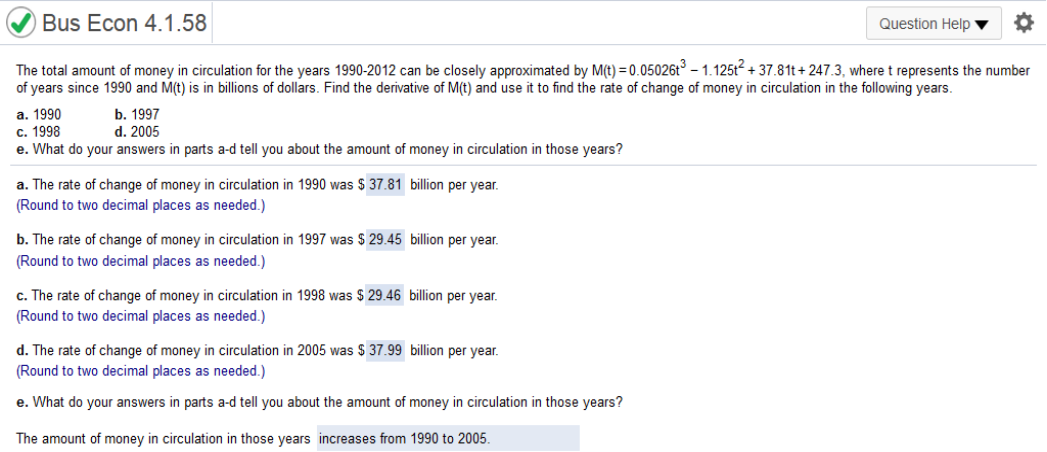
Find the derivative of 0.05026t3 - 1.125t2 + 37.81t + 247.3 = 0.15078t2 -2.25t + 37.81 Plug in 1990 – 1900 = 0 .15078(0)2 -2.25(0) + 37.81 = 37.81 The rate of change of money in circulation in 1997 __ was billion per year. Plug in 1997 – 1990 = 7 .15078(7)2 - 2.25(7) + 37.81 = 29.4482 = 29.45 The rate of change of money in circulation in 1998 __ was billion per year. Plug in 1998 – 1990 = 8 .15078(8)2 - 2.25(8) + 37.81 = 29.4482 = 29.4599 = 29.46 The rate of change of money in circulation in 2005 __ was billion per year. Plug in 2005 – 1990 = 15 .15078(15)2 - 2.25(15) + 37.81 = 29.4482 = 37.99 ever run distances from 100 yards to 10 miles. His formula is given by =.0588s1.125 where s is the distance in meters and t is the time to run that distance in seconds. Find Kennelly's estimate for the fastest a human could possibly run 1603 meters. 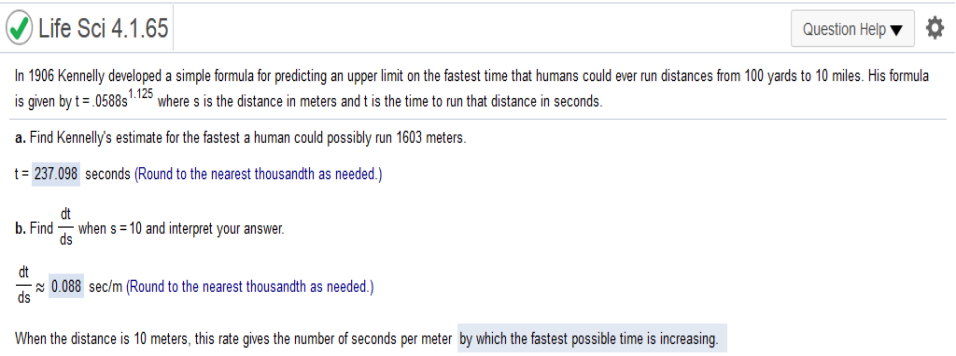
0.0588(1603)1.125 = 237.098 Find dt/ds when s = 10 and interpret your answer. Find the derivative of .0588s1.125 = .06615s.125 Plug in 10 .06615(10).125 = 0.088212 When the
distance is 10 meters, this rate gives the number of seconds per meter Answer: by which the fastest possible time is increasing. for the given position function, find (a) v(t) and (b) the velocity when t = 0, t = 4, and t = 8 s(t) = 17t2 – 14t + 6
Then plug in the values of t. If a function s(t) gives the position of a function at time t, the derivative gives the velocity, that is, v(t) = s’(t). for the given position function, find (a) v(t) and (b) the velocity when t = 0, t = 3, and t = 8 s(t) = -3t3 +6t2 -7t + 3 Find (a) v(t) and (b) the velocity when t = 0, t = 3, and t = 8.
A. The power rule B. The sum or difference rule C. The constant rule D. The constant times a function rule Find the derivative of -3t3 +6t2 -7t + 3 = -9t2 + 12t – 7 Plug in the values of t -9(0)2 + 12(0) – 7 -9(3)2 + 12(3) – 7 -9(8)2 + 12(8) – 7 Part 1 What is the correct way of writing the derivative of y?
This is the correct way of writing the derivative of y, however, I do not solve these types of problems that way. The choice is up to you, but I can solve this problem in less than one minute my way. The other way is confusing and requires much more simplifying. Part 2 Whenever you see Okay, so we need to find the derivative of (4x2 + 5) (5x – 4) We factor (4x2 + 5) (5x – 4) first. 4x2(5x) = 20x3 4x2(-4) = -16x2 5(5x) = 25x We are left with 20x3 – 16x2 + 25x Derivatives of 20x3 3(20x)3 – 1 = 60x2 – 16x2 2(-16x)2 – 1 = -32x + 25x 1(25x)1 – 1 = 25 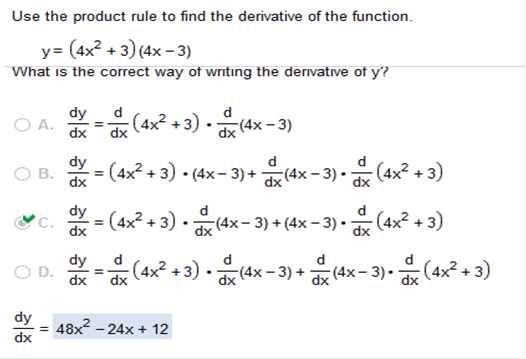
There is nothing different about this than the problem we just solved. We factor y = (4x2 + 3) (4x – 3) first. I will solve the next one. You can practice this one on your own. The answer is: 48x2 – 24x + 12
Whever we see an equation like (3x2 + 2) (2x – 3) in Calculus, we need to factor first. First, we need to factor (3x2 + 2)(2x – 3) 3x2(2x) = 6x3 3x2(-3) = -9x2 2(2x) = 4x 2(-3) = -6 This leaves us with 6x3 – 9x2 + 4x – 6 Now we need to find the derivative of 6x3 – 9x2 + 4x – 6 The derivative of 6x3 is 3(6) (x3 – 1) or 18x2 The derivative of -9x2 is 2(-9) (x2 – 1) or -18x The derivative of 4x is 1(4) (x1 – 1) or 4 The derivative of -6 is 0 Now we put the derivative back in order. 18x2 – 18x +4 Differentiate. F(x) = (3x + 2)2
(3x + 2)2 is the same as (3x + 2) (3x + 2) The same as above 3x(3x) = 9x2 3x(2) = 6x 2(3x) = 6x 2(2) = 4 So, we are left with 9x2 + 6x + 6x + 4 (simplified to) 9x2 + 12 + 4 Now we need to find the derivative of 9x2 + 12 + 4 2(9) (x2 – 1) = 18x (x1 is the same as x) 1(12) (x1 – 1) = 12 The derivative of 4 = 0 So, the answer is 18x + 12
let x(x) = 3√ + 2 then v’ = 3/2-1/2 (v’ is derivative) x + 9(3/2-1/2) + 3√x + 2(1) simplify 3/2x1/2 + 27/2x-1/2 + (3√x + 2)(1) Simplify 3/2x1/2 + 27/2x-1/2 + 3x1/2 + 2 Combine like terms. 3/2x1/2 + 3x1/2 = 9/2x1/2 + 27/2x-1/2 + 2 = 9/2x1/2 + 27/2x-1/2 + 2 Homework Chapter
1A 1B 2A 2B 3A 3B 4A 4B 5A 6A Chapter Tests 1 2 3 4 5 6 7 FINAL EXAM Need A Tutor? Need Homework Help?
|
| Home |
Accounting & Finance | Business |
Computer Science | General Studies | Math | Sciences |
Civics Exam |
Everything
Else |
Help & Support |
Join/Cancel |
Contact Us |
Login / Log Out |
